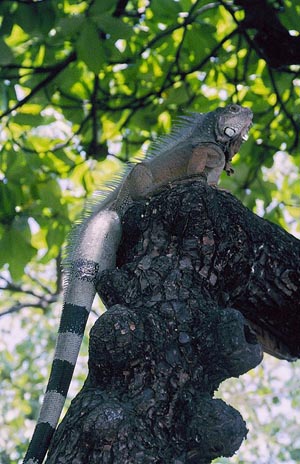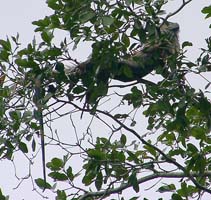Iguana
 Iguana
(Iguana iguana). The common iguana (shown
at left) begins life as a small green lizard-like creature that becomes dark brownish
black as a grown-up. It can reach 6 feet in length (but most of that is tail).
Iguanas spend most of their time in the trees, and are usually vegetarians by the
time they become adults. (No, the adults aren't watching their waistlines. As
they grow larger, the amount of food energy they would get from chasing smaller creatures
just isn't worth it - plants sit there and wait to be eaten, so are a more efficient
supply of iguana food. Smaller iguana youngsters do chase after insects, but they
don't have the bulk, so the insects are good food for them). Human animals have
absolutely nothing to fear from iguanas - iguanas will run away - and if near water, will
probably jump in when threatened (iguanas are great swimmers).
Iguana
(Iguana iguana). The common iguana (shown
at left) begins life as a small green lizard-like creature that becomes dark brownish
black as a grown-up. It can reach 6 feet in length (but most of that is tail).
Iguanas spend most of their time in the trees, and are usually vegetarians by the
time they become adults. (No, the adults aren't watching their waistlines. As
they grow larger, the amount of food energy they would get from chasing smaller creatures
just isn't worth it - plants sit there and wait to be eaten, so are a more efficient
supply of iguana food. Smaller iguana youngsters do chase after insects, but they
don't have the bulk, so the insects are good food for them). Human animals have
absolutely nothing to fear from iguanas - iguanas will run away - and if near water, will
probably jump in when threatened (iguanas are great swimmers).
Iguanas lay eggs in sand or dirt (about 50 at at
time). Once the eggs are laid, the mother iguana deserts them, so only about 10 or
so of the babies born will actually survive to adulthood. Baby iguanas take about 2
years to mature.
 The Placencia area also has a goodly number of green
iguanas - common iguanas that are - - you guessed it - green in color rather than brownish
black like the guy above. (A green iguana that lives in our neighborhood is shown at
right, click on the image for a better view.) The green coloring is primarily a camouflage to help them blend into trees
better to avoid predators.
The Placencia area also has a goodly number of green
iguanas - common iguanas that are - - you guessed it - green in color rather than brownish
black like the guy above. (A green iguana that lives in our neighborhood is shown at
right, click on the image for a better view.) The green coloring is primarily a camouflage to help them blend into trees
better to avoid predators.
 Green iguanas are the iguanas locally called
"Bamboo Chicken" -- a delicacy among some Central Americans.
Green iguanas are the iguanas locally called
"Bamboo Chicken" -- a delicacy among some Central Americans.
Green iguanas have longer fingers and tails than
the common iguana, and the tail can be used as a weapon - it's quite sharp and the iguana
uses it by sawing it rapidly through the are. The tail will also break off if caught
by a predator, but grows back as a matter of course, without any ill effects or scars.
Green iguanas also have a great sense of smell and good vision. Their skin is
very tough and they can leap 40-50 feet onto the ground without being hurt.
Green iguanas are not endangered, but in some
areas of Central America are threatened by humans who eat them - - and also humans who collect them
for sale in other countries as pets.

